学术英语理工类Unit-1答案
- 格式:pptx
- 大小:281.34 KB
- 文档页数:67

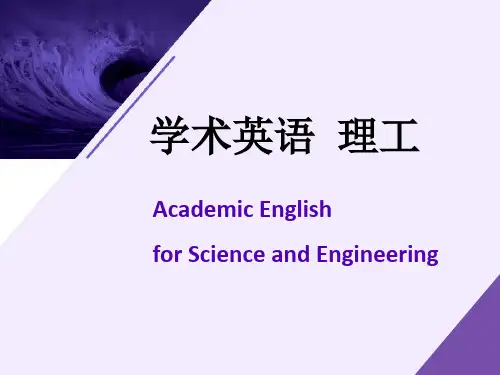
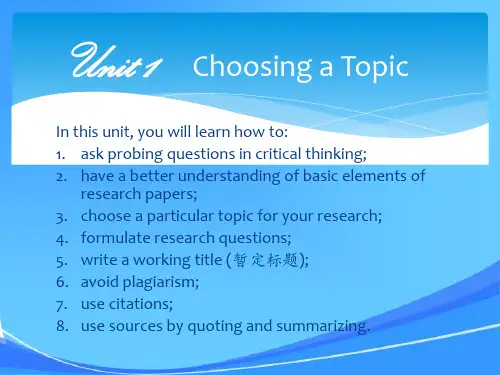
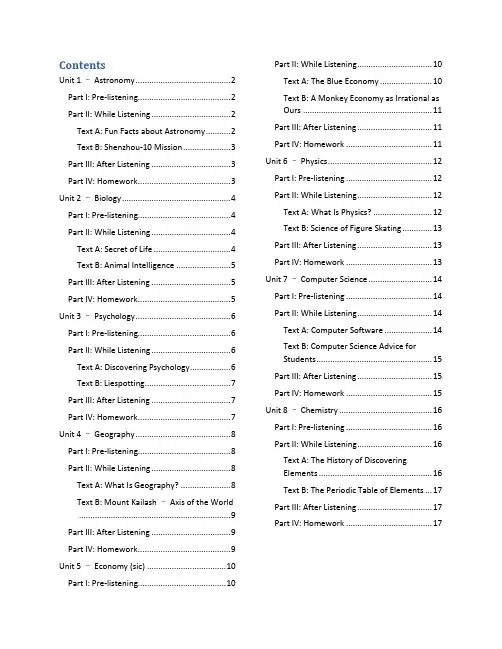
ContentsUnit 1 – Astronomy (2)Part I: Pre-listening (2)Part II: While Listening (2)Text A: Fun Facts about Astronomy (2)Text B: Shenzhou-10 Mission (3)Part III: After Listening (3)Part IV: Homework (3)Unit 2 – Biology (4)Part I: Pre-listening (4)Part II: While Listening (4)Text A: Secret of Life (4)Text B: Animal Intelligence (5)Part III: After Listening (5)Part IV: Homework (5)Unit 3 – Psychology (6)Part I: Pre-listening (6)Part II: While Listening (6)Text A: Discovering Psychology (6)Text B: Liespotting (7)Part III: After Listening (7)Part IV: Homework (7)Unit 4 – Geography (8)Part I: Pre-listening (8)Part II: While Listening (8)Text A: What Is Geography? (8)Text B: Mount Kailash – Axis of the World (9)Part III: After Listening (9)Part IV: Homework (9)Unit 5 – Economy (sic) (10)Part I: Pre-listening (10)Part II: While Listening (10)Text A: The Blue Economy (10)Text B: A Monkey Economy as Irrational asOurs (11)Part III: After Listening (11)Part IV: Homework (11)Unit 6 – Physics (12)Part I: Pre-listening (12)Part II: While Listening (12)Text A: What Is Physics? (12)Text B: Science of Figure Skating (13)Part III: After Listening (13)Part IV: Homework (13)Unit 7 – Computer Science (14)Part I: Pre-listening (14)Part II: While Listening (14)Text A: Computer Software (14)Text B: Computer Science Advice forStudents (15)Part III: After Listening (15)Part IV: Homework (15)Unit 8 – Chemistry (16)Part I: Pre-listening (16)Part II: While Listening (16)Text A: The History of DiscoveringElements (16)Text B: The Periodic Table of Elements (17)Part III: After Listening (17)Part IV: Homework (17)Unit 1 – AstronomyPart I: Pre-listeningC: Listening Exercise1. D – Mars.2. C – For finding their way across hugeareas of ocean.3. C – Almost every ancient culture knewof these five mysteries.4. A – Saturn, Jupiter, Venus, Mercury andMars.5. C – The study of stars.Part II: While ListeningText A: Fun Facts about Astronomy Exercise 1 – Global Understanding1.Two branches: (1) observationalastronomy and (2) theoreticalastronomy.2.Aspects: fun facts about (3) the sun(4) the moon(5) the stars(6) the planetsExercise 2 – Listening and Note-takingThe better notes are _A_, because:1.Good notes should consist of keywordsor very short sentences, not every word.e abbreviations and symbols thatmake sense to you can help you writedown notes quickly.3.Leave space between topics or ideas soyou can scan the page more easily later. Exercise 3 – In-depth Listening1.Mercury is the (1) second smallestplanet in the solar system and has (2)no moon. It can get as hot as (3) 800 °Cand cold as (4) 300 °C below zero. Oneyear on Mercury is equal to (5) 88 dayson Earth.2.Venus is the only planet that rotatesfrom (6) east to west. A year on thisplanet is equal to (7) 225 days on Earth.3.Earth is nearly (8) 93 million miles awayfrom the sun. It takes about (9) 16million horsepower to break the Earth’sgravitational pull.4.According to scientists, in around (10) 5billion years, a day on Earth will be (11)48 hours long and somewhere duringthat time the sun will explode.5.The planet Neptune was discoveredmore than (12) 150 years ago in 1846,and since then it still has to complete anorbit around the sun, as one Neptuneyear equals to (13) 165 Earth years.6.Pluto’s size is very small which madescientists demote it to a (14) dwarfplanet status.Text B: Shenzhou-10 MissionExercise 1 – Global Understanding1.June 24th.2.China hasn’t set up a permanent spacestation.Exercise 2 – Listening for Details1.False2.True3.Not GivenExercise 3 – Compound Dictation1.blasted off2.docked3.conduct experiments4.June 20th5.gave a lecture6. a manual docking procedure7.spoke8.two-way video link9.flew around10.the modulePart III: After ListeningPart IV: HomeworkA – Listening Task1.supremacy2.gesture3.vowed4.hostile5.decade6.mission7.spotted8.It was five kilometers from base andthey were running dangerously short oftime9.The orange soil looked like evidence ofrecent volcanic activity 10.In just half an hour, Schmitt and Cernangathered all the orange soil they couldlay hands onUnit 2 – BiologyPart I: Pre-listeningA: Talk about the Topic1.Hummingbird (c); Marmoset (a); Ostrich(d); Sloth (b); Venus flytrap (g); Cheetah(f); Bamboo (h); Rafflesia (e)2.as sly as a fox; as timid as a hare; ascheerful as a lark; as silly as a goose; asgreedy as a wolf; as proud as a peacock;as strong as a horse; as brave as a lion;as gentle as a lamb; as stubborn as amule; as busy as a bee; as blind as a bat C: Listening Exercise1. D – Hostess and guest.2. B – Genetically modified organism.3. A – Corns with a 4-digit PLU code.4. C – Because there is no proof that GMfoods are safe.5. C – From PLU code on the produce. Part II: While ListeningText A: Secret of LifeExercise 1 – Global Understanding1.nucleus2.mush3.membranes4.protein5.energy6.chromosomesExercise 2 – Listening and Note-taking1.frogspawn2.divide and divide3.replicating4.specialize5.body parts6.true of us7. a single cell8.two fundamental rules of life9.made of cells10.other cells11.what life wasExercise 3 – In-depth Listening1.17th2.Robert Hooke3.microscope4.snowflakes5.natural fibers6.mid-19th7.resurfaced8.well-engineered9.exposeText B: Animal IntelligenceExercise 1 – Global Understanding1. B – To prove that dolphins are thinkingspecies.2. C – Self-awareness.Exercise 2 – Listening for Details1.True2.Not Given3.False4.True5.FalseExercise 3 – Compound Dictation1.reacting2.another dolphin3.back and forward4.testing to see5.the same things6.neck stretches7.marked part8. a mirror9. a toolPart III: After ListeningPart IV: HomeworkA – Listening Task1.filtered sunlight2.fade3.sensitive4.evaporate5.pebbles6.moist7.snippers8.start up9.indestructible10.raise alarm11.a shadier location 12.polluted water13.reddish14.decaying or mushy15.indoor environmentsUnit 3 – PsychologyPart I: Pre-listeningA: Talk about the Topic2.1-d, 2-a, 3-f, 4-g, 5-c, 6-e, 7-h, 8-b C: Listening Exercise1. B – He has just moved to a new place.2. A – He should take Fido to the vet.3. D – He will put his dog on medication.4. A – Dog emotions are quite similar tothe emotions of humans.5. C – Harry is an expert on brain scienceof humans and dogs.Part II: While ListeningText A: Discovering Psychology Exercise 1 – Global Understanding1.behavior of individuals2.mental processes3.dispositional factors4.situational factors5.experimental psychology laboratory6.Principles of PsychologyExercise 2 – Listening and Note-taking1.sci entific study2.res earch3.pred ict & (ctrl) control behav ior4.gene tic5.att itudes, ment al6.sens ory stimul ation7.rew ards, act ionsExercise 3 – In-depth Listening1.18792.Germany3.first experimental psychologylaboratory4.18836.first American psychological laboratory7.18909.psychological text10.Principles of PsychologyText B: LiespottingExercise 1 – Global Understanding1. D – He peppered his account with alittle too much detail.2. B – A fake smile will betray a liar. Exercise 2 – Listening for Details1.Not Given2.False3.False4.True5.FalseExercise 3 – Compound Dictation1.lower2.pause3.pepper4.detail5.chronological6.backwards7.words8.gesturesPart III: After ListeningPart IV: HomeworkA – Listening Task1.signs of the condition2.low levels of light3.severe form4.thoughts of death or suicide5.designed6.sleep7.active8.sugary water9.more depressed10.least11.blue and white light12.dim red 13.signals14.natural sleep-wake cycle15.recommendation16.exposure17.bluish18.reddishUnit 4 – GeographyPart I: Pre-listeningA: Talk about the Topic1.a. 4.5 to 4.6 billion yearsb.149,597,870 kmc.384,403.1 kmd.Mt. Everest, Asia: 8844.43 me.Dead Sea: -422 mf.Mariana Trench, Western PacificOcean: 11,034 mg.56.7°C (Greenland Ranch in DeathValley, California, July 10, 1913)h.-89.2°C (Vostok, Antarctica, July 21,1983)2.1-a; 2-c; 3-f; 4-b; 5-e; 6-d; 7-gC: Listening Exercise1. D – New Zealand.2. C – The south of the country can bewarm in summer.3. C – A map showing geographicalfeatures.4. B – The coverage of oceans.5. C – She wants to know more aboutgeography.Part II: While ListeningText A: What Is Geography?Exercise 1 – Global Understanding1.Cultural geography focusing on peopleand cultures.2.Physical geography focusing on planetEarth. Exercise 2 – Listening and Note-takingFive these of geographyA. LocationB. PlaceC. Human-environment Interaction1. Humans depend on the environment2. Humans modify the environment3. Humans adapt to the environmentD. MovementE. Region1. Formal regions2. Functional regions3. Vernacular regionsExercise 3 – In-depth Listening1.earth2.to write3.climates4.plant and animal distributionputerized mapping6.data analysisText B: Mount Kailash – Axis of the World Exercise 1 – Global Understanding1. A – Because it matches the legend ofthe axis of the world.2. D – Because it is the most importantpilgrimage site in Tibet.Exercise 2 – Listening for Details1.False2.True3.Not Given4.False5.FalseExercise 3 – Compound Dictation1.pilgrimage site2.Buddha’s e nlightenment3.newly dressed altar4.prayer flags5.end up straight6.wind horsesPart III: After ListeningPart IV: HomeworkA – Listening Task1.233 countries2. a bit ambiguous3.semi-presidential republic4.6,592,800 square miles5.northern part of Asia6.11 different time zones7.climate conditions8.energy and minerals9.greatest forest reserves10.unfrozen freshwater11.ninth most populous12.lungs of Europe13.by volume 14.780 species of birds15.third largest economy16.fastest aging country17.Three Gorges Dam18.at a country’s disposalUnit 5 – Economy (sic)Part I: Pre-listeningA: Talk about the Topicpete with one another; positive; aninvisible hand2. a long time; stall along the wayC: Listening Exercise1. B – He is interested in making modelboats.2. C – She is considerate and thoughtful.3. A – It will help children learn the valueof money.4. D – He will give Jacky a regularallowance soon.5. D – Saving money for larger costs willhelp children learn how to budget. Part II: While ListeningText A: The Blue EconomyExercise 1 – Global Understanding1.expensive2.not smart3.creative4.healthy and happy5.what we did not know we have Exercise 2 – Listening and Note-taking1.healthy and naturalanic3.solar energy4.biodegradable5.palm oil6.destroy the rain forest7.subsidies8.tax moneypete with food10.damaging the climate11.expensive12.not smartExercise 3 – In-depth Listening1.Not Given2.True3.False4.TrueText B: A Monkey Economy as Irrational as OursExercise 1 – Global Understanding1. D – When they are facing a loss.2. A – People are irrational because theywant to make more money.Exercise 2 – Listening for Details1.10002.10003.04.5005.Play it safe6.20007.10008.09.50010.Take a riskExercise 3 – Compound Dictation1.different directions2.good or not3.switch4.loss mindset5.risky6.worrying7.losing stocks longer8.sell their housePart III: After ListeningPart IV: HomeworkA – Listening Task1.economic prosperity2.support strengthening3.premier forum4.lowering tariffs5.non-discriminatory6.greater participation7.integrated economic community8.critical energy sector9.interconnectivity10.renewablepletion of negotiations12.far-reaching trade agreement13.rules-based and high-standard14.mere short term15.multilaterial and bilateral partnershipsUnit 6 – PhysicsPart I: Pre-listeningA: Talk about the Topic1.1-f; 2-b; 3-e; 4-d; 5-g; 6-a; 7-h; 8-c C: Listening Exercise1. B – They are doing a physicalexperiment.2. C – Six.3. D – Judy helped to pinch the balloontight.4. B – Mike is very smart.5. A – They pumped some gas into theballoon.Part II: While ListeningText A: What Is Physics?Exercise 1 – Global UnderstandingTwo categories of physics:(1) Classical physics(2) Modern physicsMain purposes of learning physics:(1) To understand the world around people(2) To explain the universe at large Exercise 2 – Listening and Note-taking1.Definition2.motion of matter3.space and time4.energy5.force6.effects7.philosophy8.world9.classical10.modern11.Applications12.electromagnetism13.mechanics14.quantum physics Exercise 3 – In-depth Listening1.matter moves2.object attraction3.heat and energy4.mass-energy5.space-time6.electric chargesText B: Science of Figure Skating Exercise 1 – Global Understanding1. C – The science of figure skating.2. D – All of the above.Exercise 2 – Listening for Details1.False2.False3.True4.Not Given5.FalseExercise 3 – Compound Dictation1.action and reaction2.vertical velocity3.velocity4.higher5.spin6.extended7.slowly8.closer9.faster10.following11.Conservation of Angular Momentum Part III: After ListeningPart IV: HomeworkA – Listening Task1.powered by sun light2.20153.63 meters across4.200 square meters5.cells6.140 kilometers7.8,500 meters8.stops9.20 to 2510.autopilot 11.goal12.appliancesUnit 7 – Computer SciencePart I: Pre-listeningA: Talk about the Topic1.1-Wechat; 2-MSN; 3-Tencent QQ; 4-Sina Microblog; 5-Renren Network; 6-Instagram2.MSN, Tencent QQ, Renren Network,Sina MNicroblog, Instagram, Wechat C: Listening Exercise1. D – A research on the applications ofcomputers and Internet.2. C – Playing computer games.3. B – Computers can help edit jobapplication documents.4. C – Online shopping has become anessential part of our life.5. A – People may be cheated by someoneonline.Part II: While ListeningText A: Computer SoftwareExercise 1 – Global Understanding1. D – Software programs and theoperating system.2. B – A set of instructions that tells thecomputer what to do.Exercise 2 – Listening and Note-taking1.most of us don’t speak the ir language2.is like a translator3.the computer what to do4.personalized5.Mac6.Linux7.Operating system8.Software programs9. a computer store10.download from the InternetExercise 3 – In-depth Listening1.True2.FalseAn operating system can cover thebasics from saving files to fixingproblems.3.FalseYou can get computer software from acomputer store or download them fromthe Internet without the help ofcomputer engineers4.FalseSoftware programs can makecomputers personalized5.TrueText B: Computer Science Advice for StudentsExercise 1 – Global Understanding1. C – Advice for students on computerscience.2. A – Computer science is highlyinteractive.Exercise 2 – Listening for Details1.False2.True3.True4.Not GivenExercise 3 – Compound Dictation1.fallacies/misconceptions2.programming3.people4.business analysts5.discuss6.solve7.logical thinking8.capture things9.articulate10.connectingPart III: After ListeningPart IV: HomeworkA – Listening Task1.index of the web2.software programs3.webpages4.follow all the links5.chunk of the web6.hit return7.possible8.contain your keywords9.directly adjacent 10.spamming11.outside links point to itmitment13.impartial search results14.a snippet of the text15.related searches16.advertising business17.strive to18.cheetah’s top running speedUnit 8 – ChemistryPart I: Pre-listeningA: Talk about the Topic1.A, C, and E are chemical reactionsC: Listening Exercise1. A – In 1828.2. D – He created them from twoinorganic substances.3. C – People isolated it from living things.4. C – It proved that organic substancescan be created from inorganicsubstances.5. D – Atoms.Part II: While ListeningText A: The History of Discovering ElementsExercise 1 – Global Understanding1.diversity of natureplexity of man3.92 elements4.the most important codes5.making of the modern world Exercise 2 – Listening and Note-taking1.what an element is2.lead, copper, gold, silver, iron, mercury,tin3.metals4.earth, air, fire, and water5.16th6.metals into goldExercise 3 – In-depth Listening1.attempted2.electricity3.natural4.ultimately5.insight6.physics7.mysteries8.detective9.centuries10.struggled11.fascination12.destructionText B: The Periodic Table of Elements Exercise 1 – Global Understanding1. B – How the periodic table of elementswas discovered and its significance.2. B – It changes the way that everyonewould learn and understand theelements.Exercise 2 – Listening for Details1.True2.False3.Not Given4.True5.FalseExercise 3 – Compound Dictation1.18692.explain3.properties4.similarities5.patterns6.vertical7.resembled8.existence and properties9.rightPart III: After ListeningPart IV: HomeworkA – Listening Task1.green leaves2.grows underground3.for their taste4.traditionally for health reasons5.seeking to lose weight6.desire to eat7.reduce hunger8.Over six weeks9.each group 10.three-tenths of a gram11.normally eat12.especially true13.may be lost14.extend the effectiveness15.a tropical plant16.its medical possibilities17.earlier evidence18.brains of patients19.sixty to ninety-three years old20.rarely or never。
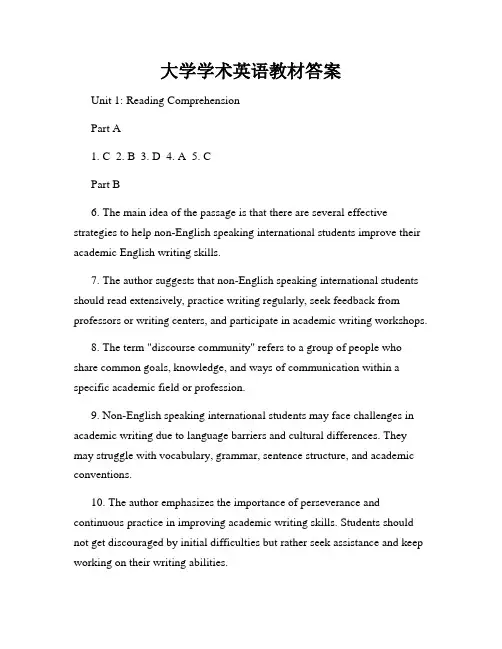
大学学术英语教材答案Unit 1: Reading ComprehensionPart A1. C2. B3. D4. A5. CPart B6. The main idea of the passage is that there are several effective strategies to help non-English speaking international students improve their academic English writing skills.7. The author suggests that non-English speaking international students should read extensively, practice writing regularly, seek feedback from professors or writing centers, and participate in academic writing workshops.8. The term "discourse community" refers to a group of people who share common goals, knowledge, and ways of communication within a specific academic field or profession.9. Non-English speaking international students may face challenges in academic writing due to language barriers and cultural differences. They may struggle with vocabulary, grammar, sentence structure, and academic conventions.10. The author emphasizes the importance of perseverance and continuous practice in improving academic writing skills. Students should not get discouraged by initial difficulties but rather seek assistance and keep working on their writing abilities.Unit 2: Vocabulary and GrammarPart A11. intensify12. abstract13. biased14. acquire15. fundamental16. authentic17. subtle18. context19. coherent20. graspPart B21. The internet has revolutionized the way we access information.22. The new manager aims to streamline the company's operations and increase efficiency.23. The scientist conducted a comprehensive study on the impact of climate change.24. The concert attracted a diverse audience of all ages and backgrounds.25. The legal system should ensure equal treatment and justice for all individuals.Unit 3: Listening ComprehensionPart A26. B 27. C 28. A 29. D 30. DPart B31. The main purpose of the presentation is to inform the audience about the benefits of studying abroad.32. The presenter mentions that studying abroad can help students develop cross-cultural communication skills and enhance their global perspectives.33. The presenter mentions that studying abroad can provide students with opportunities to immerse themselves in a different academic environment and gain a deeper understanding of their field of study.34. The presenter suggests that studying abroad can contribute to personal growth and self-confidence, as students face challenges and adapt to a new cultural context.35. In conclusion, the presenter encourages students to consider studying abroad as a valuable and transformative experience that can enrich their personal and academic lives.Unit 4: SpeakingPart A36. There are several potential advantages of group work in academic settings. First, it promotes collaboration and teamwork skills, which are highly valued in many professions. Second, it allows for the sharing of diverse perspectives and ideas, which can lead to deeper learning and innovative solutions. Third, it helps develop communication and interpersonal skills as students interact and negotiate with their peers. Overall, group work provides a more engaging and interactive learning experience.Part B37. In my opinion, the most effective method of note-taking depends on individual preferences and learning styles. For visual learners, using mind maps or diagrams can be helpful in organizing information. For auditory learners, recording lectures and listening to them later can aid in comprehension. For kinesthetic learners, hands-on activities such as drawing or writing summaries can facilitate retention. Ultimately, students should experiment with different methods and find what works best for them.Unit 5: WritingPart A38. Introduction: The purpose of this essay is to discuss the advantages and disadvantages of using social media in education.39. Advantages: Social media can facilitate communication between students and professors, allow for easy access to educational resources, and promote collaborative learning.40. Disadvantages: Social media can lead to distractions, privacy concerns, and potential misinformation or lack of credible sources.41. Conclusion: In conclusion, the use of social media in education has both positive and negative implications. It is crucial for educators and students to approach it mindfully, making use of its benefits while being aware of its drawbacks.Part B42. In my opinion, it is essential for universities to provide academic English courses for non-English speaking students. These courses can help students improve their language skills, particularly in academic writing and speaking. Proficiency in academic English is crucial for success in higher education and future careers. Additionally, these courses can also provide cultural orientation and support, helping international students navigate the challenges of studying in a foreign country. Overall, academic English courses contribute to a more inclusive and supportive learning environment for all students.Note: This sample answer is for reference only and may vary depending on the specific questions and content of the textbook. It is recommended to refer to the actual textbook or teaching materials for accurate and complete answers.。
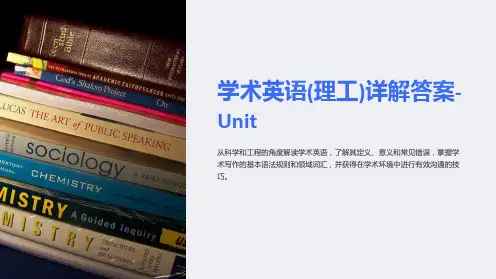

学术综合英语参考答案unit1学术综合英语参考答案Unit 1一、词汇与语法1. 词汇题- (1) 正确答案:A. 显著的- (2) 正确答案:C. 影响- (3) 正确答案:B. 观点- (4) 正确答案:D. 概念- (5) 正确答案:E. 假设2. 语法题- (1) 正确答案:Whoever has the ability can apply for the position.- (2) 正确答案:Despite the heavy rain, they continued their journey.- (3) 正确答案:Not only did he finish his homework but he also helped his sister.- (4) 正确答案:It is the first time that she has visited the museum.- (5) 正确答案:Such is the power of nature that no one can resist it.二、阅读理解1. 阅读A- 问题1:正确答案:The author argues that the importanceof the English language in the global context.- 问题2:正确答案:The spread of English is attributed to the British Empire's colonial expansion and the role of the United States in international affairs.- 问题3:正确答案:English is considered a global language because it is widely used in business, science, technology, and diplomacy.2. 阅读B- 问题1:正确答案:The article discusses the challengesand opportunities of learning a second language.- 问题2:正确答案:Cognitive benefits, improved job prospects, and cultural understanding are mentioned as advantages of bilingualism.- 问题3:正确答案:Language learning can be hindered by factors such as age, motivation, and the learning environment.三、完形填空1. 正确答案:- (1) B. 影响- (2) A. 显著的- (3) D. 观点- (4) C. 概念- (5) E. 假设- (6) F. 假设- (7) G. 观点- (8) H. 影响- (9) I. 显著的- (10) J. 概念四、翻译1. 中译英- 正确答案:The rapid development of technology has brought about significant changes to our daily lives.2. 英译中- 正确答案:全球化不仅促进了国际贸易,也增进了不同文化之间的理解和尊重。

学术英语理工教师手册Unit 1 Choosing a TopicI Teaching ObjectivesIn this unit , you will learn how to:1.choose a particular topic for your research2.formulate a research question3.write a working title for your research essay4.enhance your language skills related with reading and listening materials presented in this unit II. Teaching Procedures1.Deciding on a topicTask 1Answers may vary.Task 21 No, because they all seem like a subject rather than a topic, a subject which cannot be addressed even by a whole book, let alone by a1500-wordessay.2Each of them can be broken down into various and more specific aspects. For example, cancer can be classified into breast cancer, lung cancer, liver cancer and so on. Breast cancer can have such specific topics for research as causes for breast cancer, effects of breast cancer and prevention or diagnosis of breast cancer.3 Actually the topics of each field are endless. Take breast cancer for example, we can have the topics like:Why Women Suffer from Breast Cancer More Than Men?A New Way to Find Breast TumorsSome Risks of Getting Breast Cancer in Daily LifeBreast Cancer and Its Direct Biological ImpactBreast Cancer—the Symptoms & DiagnosisBreastfeeding and Breast CancerTask 31 Text 1 illustrates how hackers or unauthorized users use one way or another to get inside a computer, while Text2 describes the various electronic threats a computer may face.2 Both focus on the vulnerability of a computer.3 Text 1 analyzes the ways of computer hackers, while Text 2 describes security problems of a computer.4 Text 1: The way hackers “get inside” a computerText 2: Electronic threats a computer facesYes, I think they are interesting, important, manageable and adequate.Task 41Lecture1:Ten Commandments of Computer EthicsLecture 2:How to Deal with Computer HackersLecture 3:How I Begin to Develop Computer Applications2Answersmay vary.Task 5Answers may vary.2 Formulating a research questionTask 1Text 3Research question 1: How many types of cloud services are there and what are they? Research question 2: What is green computing?Research question 3: What are advantages of the cloud computing?Text 4Research question 1: What is the Web 3.0?Research question 2: What are advantages and disadvantages of the cloud computing? Research question 3: What security benefits can the cloud computing provide?Task 22 Topic2: Threats of Artificial IntelligenceResearch questions:1) What are the threats of artificial intelligence?2) How can human beings control those threats?3) What are the difficulties to control those threats?3 Topic3: The Potentials of NanotechnologyResearch questions:1) What are its potentials in medicine?2) What are its potentials in space exploration?3) What are its potentials in communications?4 Topic4: Global Warming and Its EffectsResearch questions:1) How does it affect the pattern of climates?2) How does it affect economic activities?3) How does it affect human behavior?Task 3Answers may vary.3 Writing a working titleTask 1Answers may vary.Task 21 Lecture 4 is about the security problems of cloud computing, while Lecture 5 is about the definition and nature of cloud computing, hence it is more elementary than Lecture 4.2 The four all focus on cloud computing. Although Lecture 4 and Text 4 address the same topic, the former is less optimistic while the latter has more confidence in the security of cloud computing. Text3 illustrates the various advantages of cloud computing.3 Lecture 4: Cloud Computing SecurityLecture 5: What Is Cloud Computing?Task 3Answers may vary.4 Enhancing your academic languageReading: Text 11.Match the words with their definitions.1g 2a 3e 4b 5c 6d 7j 8f 9h 10i2. Complete the following expressions or sentences by using the target words listed below with the help of the Chinese in brackets. Change the form if necessary.1 symbolic 2distributed 3site 4complex 5identify6fairly 7straightforward 8capability 9target 10attempt11process 12parameter 13interpretation 14technical15range 16exploit 17networking 18involve19 instance 20specification 21accompany 22predictable 23profile3. Read the sentences in the box. Pay attention to the parts in bold.Now complete the paragraph by translating the Chinese in brackets. You may refer to the expressions and the sentence patterns listed above.ranging from(从……到)arise from some misunderstandings(来自于对……误解)leaves a lot of problems unsolved(留下很多问题没有得到解决)opens a path for(打开了通道)requires a different frame of mind(需要有新的思想)4.Translate the following sentences from Text 1 into Chinese.1) 有些人声称黑客是那些超越知识疆界而不造成危害的好人(或即使造成危害,但并非故意而为),而“骇客”才是真正的坏人。
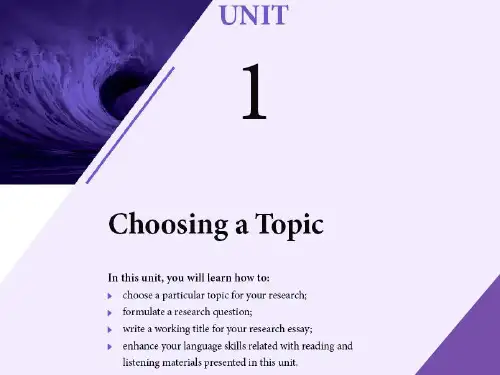

学术英语理工教师手册Unit 1Choosing a TopicI Teaching ObjectivesIn this unit , you will learn how to:a particular topic for your researcha research questiona working title for your research essayyour language skills related with reading and listening materials presented in this unitII. Teaching Procedureson a topicTask 1Answers may vary.Task 21 No, because they all seem like a subject rather than a topic, a subject which cannot be addressed even by a whole book, let alone by a1500-wordessay.2Each of them can be broken down into various and more specific aspects. For example, cancer can be classified into breast cancer, lung cancer, liver cancer and so on.Breast cancer can have such specific topics for research as causes for breast cancer, effects of breast cancer and prevention or diagnosis of breast cancer.3 Actually the topics of each field are endless. Take breast cancer for example,we can have the topics like:Why Women Suffer from Breast Cancer More Than Men?A New Way to Find Breast TumorsSome Risks of Getting Breast Cancer in Daily LifeBreast Cancer and Its Direct Biological ImpactBreast Cancer—the Symptoms & DiagnosisBreastfeeding and Breast CancerTask 31 Text 1 illustrates how hackers or unauthorized users use one way or another toget inside a computer, while Text 2 describes the various electronic threats acomputer may face.2 Both focus on the vulnerability of a computer.3 Text 1 analyzes the ways of computer hackers, while Text 2 describes securityproblems of a computer.4 Text 1: The way hackers“get inside” a computerText 2: Electronic threats a computer facesYes, I think they are interesting, important, manageable and adequate.Task 41Lecture1:Ten Commandments of Computer EthicsLecture 2:How to Deal with Computer HackersLecture 3:How I Begin to Develop Computer Applications2Answersmay vary.Task 5Answers may vary.2 Formulating a research questionTask 1Text 3Research question 1: How many types of cloud services are there and what are they?Research question 2: What is green computing?Research question 3: What are advantages of the cloud computing?Text 4Research question 1: What is the Web ?Research question 2: What are advantages and disadvantages of the cloud computing? Research question 3: What security benefits can the cloud computing provide?Task 22 Topic2: Threats of Artificial IntelligenceResearch questions:1)What are the threats of artificial intelligence?2)How can human beings control those threats?3)What are the difficulties to control those threats?3 Topic3: The Potentials of NanotechnologyResearch questions:1)What are its potentials in medicine?2)What are its potentials in space exploration?3)What are its potentials in communications?4 Topic4: Global Warming and Its EffectsResearch questions:1)How does it affect the pattern of climates?2)How does it affect economic activities?3)How does it affect human behavior?Task 3Answers may vary.3 Writing a working titleTask 1Answers may vary.Task 21 Lecture 4 is about the security problems of cloud computing, while Lecture 5 isabout the definition and nature of cloud computing, hence it is more elementary than Lecture 4.2 The four all focus on cloud computing. Although Lecture 4 and Text 4 address thesame topic, the former is less optimistic while the latter has more confidence inthe security of cloud computing. Text 3 illustrates the various advantages of cloud computing.3 Lecture 4: Cloud Computing SecurityLecture 5: What Is Cloud Computing?Task 3Answers may vary.4 Enhancing your academic languageReading: Text 1the words with their definitions.1g 2a 3e 4b 5c 6d 7j 8f 9h 10iwords listed 2. Complete the following expressions or sentences by using the targetbelow with the help of the Chinese in brackets. Change the form if necessary.1 symbolic 2distributed3site4complex 5identify6fairly 7straightforward 8capability 9target10attempt11process 12parameter13interpretation14technical15range 16exploit17networking18involve19 instance 20specification 21accompany22predictable23profile3. Read the sentences in the box. Pay attention to the parts in bold.Now complete the paragraph by translating the Chinese in brackets. You may refer to the expressions and the sentence patterns listed above.ranging from(从⋯⋯到)arise from some misunderstandings leaves a lot of problems unsolved opens a path for(打开了通道)requires a different frame of mind (来自于⋯⋯ 解)(留下很多没有得到解决)(需要有新的思想)the following sentences from Text 1 into Chinese.1)有些人声称黑客是那些超越知疆界而不造成危害的好人(或即使造成危害,但并非故意而),而“ 客”才是真正的坏人。
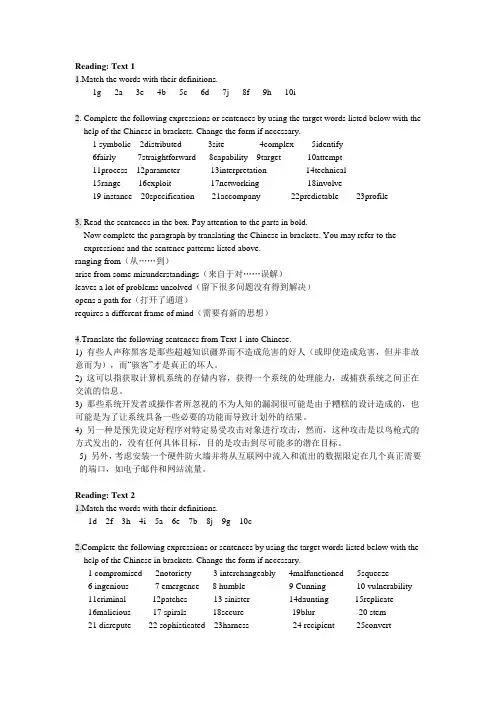
Reading: Text 11.Match the words with their definitions.1g 2a 3e 4b 5c 6d 7j 8f 9h 10i2. Complete the following expressions or sentences by using the target words listed below with the help of the Chinese in brackets. Change the form if necessary.1 symbolic 2distributed 3site 4complex 5identify6fairly 7straightforward 8capability 9target 10attempt11process 12parameter 13interpretation 14technical15range 16exploit 17networking 18involve19 instance 20specification 21accompany 22predictable 23profile3. Read the sentences in the box. Pay attention to the parts in bold.Now complete the paragraph by translating the Chinese in brackets. You may refer to the expressions and the sentence patterns listed above.ranging from(从……到)arise from some misunderstandings(来自于对……误解)leaves a lot of problems unsolved(留下很多问题没有得到解决)opens a path for(打开了通道)requires a different frame of mind(需要有新的思想)4.Translate the following sentences from Text 1 into Chinese.1) 有些人声称黑客是那些超越知识疆界而不造成危害的好人(或即使造成危害,但并非故意而为),而“骇客”才是真正的坏人。
Reading: Text 11.Match the words with their definitions.1g 2a 3e 4b 5c 6d 7j 8f 9h 10i2. Complete the following expressions or sentences by using the target words listed below with the help of the Chinese in brackets. Change the form if necessary.1 symbolic 2distributed 3site 4complex 5identify6fairly 7straightforward 8capability 9target 10attempt11process 12parameter 13interpretation 14technical15range 16exploit 17networking 18involve19 instance 20specification 21accompany 22predictable 23profile3. Read the sentences in the box. Pay attention to the parts in bold.Now complete the paragraph by translating the Chinese in brackets. You may refer to the expressions and the sentence patterns listed above.ranging from(从……到)arise from some misunderstandings(来自于对……误解)leaves a lot of problems unsolved(留下很多问题没有得到解决)opens a path for(打开了通道)requires a different frame of mind(需要有新的思想)4.Translate the following sentences from Text 1 into Chinese.1) 有些人声称黑客是那些超越知识疆界而不造成危害的好人(或即使造成危害,但并非故意而为),而“骇客”才是真正的坏人。